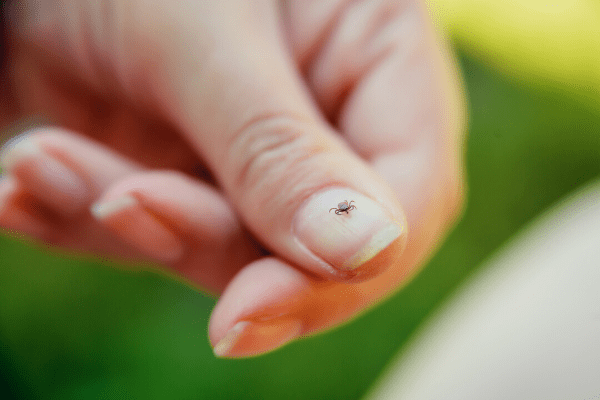 I’m sure that in the wake of a global pandemic, illnesses are the last thing that moms want to hear about right now. But, May is Lyme Disease Awareness Month, and with permission from my son Noah and my niece Jordan, here are their stories.
I’m sure that in the wake of a global pandemic, illnesses are the last thing that moms want to hear about right now. But, May is Lyme Disease Awareness Month, and with permission from my son Noah and my niece Jordan, here are their stories.
A few years ago on Halloween, I was getting my three kids ready to trick or treat. We were putting on costumes and face makeup, grabbing pillowcases to take around the neighborhood to fill up with candy. But my oldest, Noah, who was around 11 at the time, decided that he didn’t feel like walking around the neighborhood. He laid down on the couch and said he wanted to nap instead.
My kid didn’t want to get free candy?! I knew that in order for him to turn down free candy, he had to really not be feeling well. For the past few weeks, he’d also been complaining that his legs hurt. Those complaints, along with his penchant for napping, were all quickly dismissed by me as the dreaded signs of puberty. I told him he was having growing pains, that his body was going through changes, and that it’d all be over soon.
But as soon as he turned down candy on Halloween, I knew that something bigger was wrong. I talked to his stepmother (she’s a nurse, and she’s awesome) on the phone and she agreed that it was time to take Noah to visit the doctor.
Turns out, Noah had Lyme Disease. It wasn’t even on my radar – and I felt awful once we got the diagnosis. Here I’d been dismissing his complaints and symptoms and telling him to just wait it out. After a course of some strong antibiotics, Noah was back to normal and has no lasting effects of Lyme.
Noah’s story with Lyme Disease is about as best-case scenario as you can get.
I want to share some of my niece’s story, though, with permission from my brother Matt and his wife, Tina. My niece Jordan just turned 18. She’s active in her school, she plays violin, and is a high achiever. In September of 2018, Jordan came down with flu-like symptoms and a low-grade fever. They went to the pediatrician and after a few days, Jordan’s physical symptoms subsided.
But new, scary symptoms emerged. Jordan was having trouble with her homework. She was having trouble comprehending what she was reading, and couldn’t do basic math. At the second visit to the doctor, my concerned and astute sister-in-law asked outright if this could be Lyme. She was assured that no, this wasn’t Lyme – but there was no diagnosis given, and no answers.
Jordan’s symptoms worsened. Within a month, she was pulled from school and placed on a medical leave. She wasn’t sleeping, couldn’t even type a note on the computer, and was suffering from physical and mental exhaustion. For months, their family went without answers.
They went from doctor to doctor, they saw a neurologist, had an MRI done, and had no concrete answers. They were told that Jordan was suffering from anxiety and depression and she was started on medication. Not satisfied with this answer, Matt and Tina started digging in and doing research. They got second opinions, and in time were at the top hospitals in Atlanta. The doctors urged them to have Jordan go back to school, saying that these symptoms would subside once she was back in class and that this was “normal teenager stuff.”
It wasn’t “normal teenager stuff.”
In December 2018, after three months of Jordan displaying concerning symptoms and missing two months of the 11th grade, they went to a doctor that specialized in holistic medicine. He administered a CDC test for Lyme and Jordan finally had a diagnosis, after months of being dismissed: She had Lyme Disease.
In the following months, Jordan was given a strong antibiotic, started school again, and was weaned off the anxiety medication she had previously been prescribed. Jordan experienced maybe a 20% improvement. They adjusted her class schedule so she could complete the 11th grade to keep her on track to graduate with the rest of her class, despite her missing months of school.
Matt and Tina continued to research and look at options to help get their active, intelligent, motivated daughter back to normal. They found a facility in Mexico that worked with patients that were as severe as Jordan, but this wasn’t covered by insurance. Jordan and Tina went to this facility for two weeks, paying for everything out of their own pocket. After seeing dozens of doctors, they were ready to do anything to make Jordan better.
After Jordan’s first treatment at this facility, she could feel the effects right away. She was able to read seven chapters of a book in one sitting – something that she hadn’t done in nearly a year.
I asked Tina what her advice was to any parent that was struggling to get a diagnosis. Her advice was to continually advocate for yourself and your child. When the original diagnoses didn’t seem right, they persisted. They got second opinions, they tried new doctors, and they kept researching on their own. Finding the right diagnosis took months; finding the right treatment took even longer. In July of 2019 Jordan completed her treatment at the facility in Mexico, and miraculously she’s on track to graduate in May 2020 with her class. She’s been accepted to Georgia Southern University and will start there in the fall of 2020.
Here are some things to know about Lyme Disease:
- Everyone associates Lyme with a tick bite – but many people that contract Lyme don’t recall being bitten by a tick. Lyme can be transmitted by mosquitoes, fleas, and lice as well. (Source: CDC.gov)
- 10-15% of patients with Lyme Disease also display symptoms of impaired memory and cognitive abilities. These symptoms can show up months later and include changes in mood, impaired fine motor control, poor memory, slower speed of thinking – and these symptoms often cause misdiagnosis. (Source: Columbia University)
- Tests for Lyme are more accurate after 4-6 weeks of displaying symptoms. This means it’s possible to get a false negative when a test is administered. (Source: CDC.gov)
- A bulls-eye rash is a well-known symptom of Lyme Disease, but less than half of people with Lyme will display a rash like this. (Source: Global Lyme Alliance).
While doctors have vast knowledge and try their best, remember that they’re seeing a snapshot of your life and are making a diagnosis based off of that information. Lyme Disease often takes time to diagnose, and even longer to recover from. It’s okay to get a second opinion, to try another doctor, and to advocate for yourself and your child. You can check out the above sources for more information on Lyme Disease.
The content on Rochester Mom is not intended to be a substitute for professional medical advice, diagnosis, or treatment. Always seek the advice of your physician or other qualified health provider with any questions you may have regarding a medical condition. Never disregard professional medical advice or delay in seeking it because of something you have read on this website.





